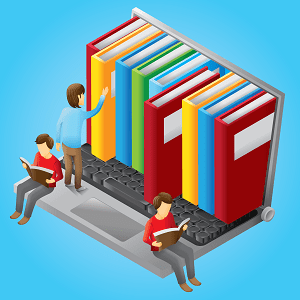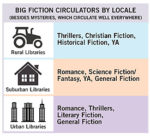But what a difference seven years makes. In 2008, print books captured 67% of the budget on average and media (comprising audiobooks, DVDs, and music), 18%. Ebooks were just on the horizon and not even counted in the survey. This year, print books account for just 59% of the budget on average—a figure that has, however, held steady in this survey’s findings over the last three years. Meanwhile, ebooks have jumped from 1% of the budget in 2009 to 7% today. Almost all respondents now offer ebooks, up from 66% five years ago.
Even more strikingly, media now accounts for 24.4% of the budget, with that number fragmenting into audiobooks (7.4%), downloadable audio (2.4%), DVDs/Blu-ray titles (12.1%), downloadable movies (0.3%), and music (2.2%).
A full 94% of respondents offer downloadable audio, which rose in circulation at the goodly clip of 9.4% on average, and 45% offer downloadable movies, with the circulation there rising by an eye-popping average of nearly 50%. All this, though circulation as a whole is generally flat, suggesting a lot of energy in media.
At 75% of the budget and 71% of circulation, book formats (print, ebooks, audiobooks, and downloadable audios) still represent a formidable chunk of the materials mix, but the variety of book and media formats now available in public libraries is dizzying. Even more dizzying for many librarians is deciding which formats to buy, in what proportions, and where to buy them. As demand explodes along with formats, librarians find that sometimes traditional vendors don’t alone do the trick.
TABLE 1: MATERIALS BUDGET BREAKDOWN
Average findings based on population served, 2014
| MATERIALS | TOTAL | Under 10K % |
10K- 24,999 % |
25K- 49,999 % |
50K- 99,999 % |
100K- 249,999 % |
250K- 499,999 % |
500K+ % |
| Books | 59 | 66 | 64 | 62 | 55 | 53 | 50 | 45 |
| Ebooks | 7 | 4 | 6 | 5 | 10 | 9 | 9 | 9 |
| Audiobooks | 7 | 10 | 8 | 6 | 6 | 7 | 7 | 4 |
| Downloadable audio | 2 | 2 | 2 | 2 | 4 | 3 | 3 | 4 |
| DVD/Blu-ray | 12 | 12 | 15 | 11 | 11 | 13 | 11 | 14 |
| Downloadable movies | 0.3 | 0 | 0.3 | 3 | 0.5 | 0.7 | 1 | 1.6 |
| Music CDs/downloadable | 2 | 1 | 2 | 2 | 2 | 4 | 3 | 4 |
| Other electronic products | 6 | 2 | 3 | 7 | 7 | 10 | 12 | 11 |
| Other | 3 | 2 | 1 | 5 | 6 | 4 | 5 | 7 |
| SOURCE: LJ materials Survey 2015 | ||||||||
MEDIA MARCH
With a different group of respondents, the 2015 materials survey reports a somewhat more robust figure than the budget survey’s 1.5% (see “Paying for People,” LJ 2/1/15, p. 30–32). Book budgets averaged $477,700 and adult book budgets, which have stumbled over the last three years, $283,300. The YA book budget is down somewhat, too, but the budget for children’s books, where ebooks aren’t stealing the thunder, has risen sharply. Print book budgets, barely breaking 60% at most libraries, are flat in all but the largest locales. There, they commanded a little bump of only 0.5%.
DVDs/Blu-rays are popular in libraries of every size, though by location they do best in suburban libraries; interestingly, they take the biggest chunk of the materials budget at smaller libraries serving populations of 10,000 to 25,999. Libraries serving populations over 500,000 spend the least amount of funding on audiobooks but are among the libraries putting the most into downloadable audio; they also invest the most in downloadable movies. Libraries serving populations over 50,000 allocate more to ebooks, and suburban libraries focus more on ebooks and DVD/Blu-rays than their urban or rural counterparts.

CIRCULATION SHIFT
Since the inception of this survey in 1998, circulation growth has often been the big story, with increases of many percentage points not uncommon. Circulation stalled in the 2012 survey, managing only a 0.1% uptick, but has been edging up since. This year’s survey, however, sees circulation flat again at 0.5% overall, with only a third of respondents reporting an increase and nearly three in ten reporting a decrease. Circulation made its best showing at libraries serving populations under 10,000, where growth averaged 2.5%; libraries serving populations of 100,000 to 499,999 saw circulation tumble by 2% overall.
Instead of growth, what’s important this year is how the escalating breakout of various formats is reshaping circulation. Book circulation has fallen nearly ten points in just four years, now claiming somewhat less than 58% of circulation; adult books account for only about half of that. But in that time, ebook circulation has increased fivefold, and media circulation has climbed from just over 29% to nearly 34%. In 2011, the materials survey didn’t break out audiobooks, downloadable audios, DVD/Blu-rays, downloadable movies, or music from its media circulation measure but has begun to do so as these formats increase in significance. This year, DVD/Blu-ray circulation constituted a whopping 22.5% of the total, and, in its first showing, downloadable audio circulation boasts an already significant 2%.

FICTION RULES
In print book circulation, fiction continues to claim the lion’s share, averaging 67% of the total. (The adult print book budget favors fiction over nonfiction by a ratio of 61% to 39% on average.) In ebook circulation, fiction does even better, accounting for 80% of the total. Once again, mystery, general fiction, and romance dominate fiction circulation in both formats, with mystery cited among the top five fiction circulators in print and ebook by 97% and 93% of respondents, respectively.
Romance and thrillers do markedly better as ebooks than in print, with 80% and 63% of respondents placing them among their top five ebook fiction circulators, respectively, compared with 68% and 50% for print fiction. Christian fiction does worse, making the top five in ebook circulation for only 27% of respondents compared with 41% for print. Literary fiction is thriving, now accounting for 22% of print circulation on average—up from only 13% in 2011—and 16% of ebook circulation.
Cooking remains the hot topic in nonfiction, again claiming the top spot in print circulation and finally shoving medicine/health from its blue-ribbon perch in expenditures as well. For the first time, it’s also a top five nonfiction circulator in ebook format, though it still does better in print. The new hot topic in nonfiction is biography/memoir, claimed by only 22% of respondents as a top five nonfiction print circulator in 2008 and now noted by 64%. It tops ebook circulation as well, favored by 84% of respondents as a top five nonfiction circulator.
TABLE 2: TRENDING OF CIRCULATION BREAKDOWN
Average findings based on population served, 2014
| MATERIALS | 2011 % | 2012 % | 2013 % | 2014 % |
| BOOK CIRCULATION | 66.8 | 61.7 | 62.8 | 57.7 |
| MEDIA CIRCULATION* | 29.1 | 31.9 | 30.6 | 33.7 |
| DVD/Blu-ray circulation | n/a | 21.2** | 20.7 | 22.5 |
| Downloadable movie circulation | n/a | n/a | 0.2 | 0.2 |
| Audiobook circulation | n/a | 7.0** | 6.6** | 6.4 |
| Downloadable audio circulation | n/a | n/a | n/a | 1.9 |
| Music CD/downloadable music circulation | n/a | 3.7** | 3.1** | 2.7** |
| EBOOK CIRCULATION | 1.5 | 3.3 | 4.4 | 5.4 |
| OTHER CIRCULATION | 2.6 | 3.1 | 2.2 | 3.2 |
| *Netted media (audiobooks, DVDs, downloadable movies & music CDs) | ||||
| **Physical and downloadable counted together. | ||||
| SOURCE: LJ materials Survey 2015 | ||||
THE MULTIFORMAT QUESTION
Once upon a time, a library’s selection decisions were relatively straightforward: which books to buy and, when relevant, in which amounts. Now, multiple formats can require multiple choices. “This is one of the greatest challenges for us, in terms of managing staff time,” says Nancy Messenger, Sno-Isle Libraries, WA. “We make the same selection decisions over and over (print vs. audio vs. e-format). I’m anxious to learn how other libraries have resolved this issue.”
Different libraries handle multiformat selection differently, with the issue crucial enough to have generated more response than any other open-ended survey question in recent memory. First up: Who does the selecting? At the Nashville Public Library, says Noel Rutherford, “The same selector decides on the title first and then chooses all formats associated with that title. We use Collection HQ to help make some of these decisions as well as branch profile charts updated once a year.” This approach offers the convenience, whenever feasible, of ordering all formats of a title at once.
Elsewhere, individual selectors work more by format, important when different formats fall under different budgets or e-materials orders are handled by a consortium. “Downloads and ebooks are a separate budget from the budget for other formats,” explains J. Randolph Call, Detroit Public Library. “Within each budget, selectors at each location respond to circulation trends identified through ILS reports as well as customer requests and experience with in-house use.”
Of course, given the size of the library, individual selectors may be working with more than one format, or they may be working in a mix of format and subjects, say, fiction and audiobooks. But they aren’t choosing all of a given title’s formats simultaneously, and they aren’t concerned with comprehensive format orders either—which some respondents say makes more sense, as a title’s various formats or even word of their existence aren’t necessarily available at the same time.
Furthermore, individual selectors do talk across formats with colleagues; the print selector might recommend a big, new title to the staff member ordering audiobooks or the consortium handling ebooks. In fact, some libraries handle the multiformat morass by committee, hashing out which formats to select for which titles across a conference room table. All sorts of arrangements prevail, and in the end, what works best for a particular library seems to depend on size, budgetary structure, and where the depth of the staff’s knowledge lies.
TABLE 3: TRENDING OF MATERIALS BUDGET BREAKDOWN
Average findings based on population served, 2014
| MATERIALS | 2008 % | 2009 % | 2010 % | 2011 % | 2012 % | 2013 % | 2014 % |
| PRINT BOOKS | 66.5 | 64.9 | 63.8 | 61.6 | 58.8 | 59.5 | 59.2 |
| MEDIA* | 18.2 | 19.7 | 19.8 | 20.4 | 24 | 23.1 | 24.4 |
| DVDs / Blu-ray titles | n/a | n/a | n/a | n/a | 11.7** | 11.7 | 12.1 |
| Downloadable movies | n/a | n/a | n/a | n/a | n/a | 0.6 | 0.3 |
| Audiobooks | n/a | n/a | n/a | n/a | 9.0** | 8.0** | 7.4 |
| Downloadable audio | n/a | n/a | n/a | n/a | n/a | n/a | 2.4 |
| Music CDs / Downloadable music | n/a | n/a | n/a | n/a | 3.3** | 2.8** | 2.2** |
| EBOOKS | n/a | 1.2 | 2.6 | 3.7 | 6.2 | 6.8 | 7.1 |
| ELECTRONIC PRODUCTS (including reference) | 10.1 | 8.9 | 7.9 | 9 | 7.3 | 6.6 | 6.1 |
| OTHER | 5.2 | 5.3 | 5.9 | 5.3 | 3.7 | 4 | 3.2 |
| *Netted media (audiobooks, DVDs, downloadable movies & music CDs) | |||||||
| **Physical and downloadable counted together. | |||||||
| SOURCE: LJ materials Survey 2015 | |||||||
DEMAND, PRICE, AVAILABILITY
Whatever the selector type, choosing what to order comes down to demand, price, and availability. Demand in any format rests on what it has always rested on in print: the author’s reputation; the past circulation of the author, like authors, and/or the subject, with the subject more important if the author is less well known; buzz in vendor reports, in the media, and on the web; the size of print runs and the promotional campaign; the number of holds; patron requests; and reviews, which nearly 40% of respondents say are still required to place an order.
Most respondents agree that the higher the demand, the more formats are needed, with the biggest titles and best-selling authors selected across as many formats as possible. Says Mary Wallace Moore, Smyrna Public Library, GA, “Only the most popular authors get the complete multiformat treatment. For example, I will gladly buy the hardcover, large print, book CD, ebook, and e-audiobook of any Lee Child title. I know it will check out in every format.” Many libraries order in ebook format only what’s truly popular in print, which generally means best-selling fiction; nonfiction is a much less likely choice. Beyond that, criteria are harder to ascertain.
About one in ten respondents say they start with print and add more formats based on demand. Sometimes, though, print doesn’t rule. Genres like mystery and romance are increasingly popular in digital formats, making ebook and downloadable audios orders almost automatic. Other genres work best as ebook-only purchases. “If it is something that people in my area would like and is well reviewed but is in a less popular genre (such as sf or fantasy), I may just buy the ebook version rather than have to weed it in a couple of years,” clarifies John Mundy, Perry County Public Library, IN.
Some respondents say they favor ebooks over print for backlist, replacement copies, completion of a series, or high-theft items, and such shifts are taking place in other formats as well. At the Billings Public Library, MT, Barbara Riebe finds that “on the fiction books I order, I have had to be more selective with CD books in recent years, as the budget has shifted dramatically toward the downloadable content.” Beyond audio copies of current best sellers, Riebe fills her collection with award winners, including Audie winners, and classics.
In general, respondents who buy audiobooks recommend focusing on fiction rather than nonfiction, where titles narrated by the authors, particularly recognizable personalities, or narrative nonfiction without heavy-duty, convoluted thought or sentence structure do best. Ebooks can offer more challenging material but can’t require a lot of page flipping, and arts, crafts, and how-to books are best left to print. Beyond popularity, respondents had no advice for choosing fiction in any format, sending selectors back to ILS or HQ reports for data on read-alike authors whenever a promising unknown surfaces.
Whatever the title and format, sometimes the price may just not be right. “The cost of some ebooks can be a major factor in deciding to purchase or not,” indicates Philip Jones, Central Arkansas Library System. “We look heavily at anticipated demand vs. cost and do not initially purchase $75–$100 ebooks and audios unless we are fairly certain there will be patron demand and circulation.” Availability is also an issue, as a particular format may not be available, at least from a contracted vendor and for a current platform. “We use OverDrive for ebooks/downloadables and Ingram and [Baker & Taylor] for books, which means that we have to shop at multiple locations to get different formats,” says Jones. In the end, using vendors that offer multiple formats is recommended, but it’s not always possible.

NONTRADITIONAL VENDORS
Probably 8% of respondents say they do not buy beyond the traditional vendors, owing to legal contracts; about 15% said such purchases were negligible, usually about 5% of the budget—though 5% of $807,000, this year’s average material budget, is nothing to brush aside. Yet other respondents say that they spend 25%, 35%, and even 40% outside the standard vendor channels. For instance, Call reports that Detroit PL spends roughly $100,000 a year and growing on nontraditional vendors, with the focus on urban fiction and materials for the Burton Historical Collection and the National Automotive History Collection.
Indeed, availability of specialized or hard-to-find material is a major reason for going beyond the standard vendors. Small press titles, titles by local authors, regional winners, books that are out of print or out of stock, backlist or replacement titles, and self-published titles—all merit nontraditional spending sprees. And, crucially, big-demand DVDs, games, and music are often most easily available this way.
Price and speed of delivery are also reasons for going the nontraditional vendor route. Amazon is often cheaper than places like Midwest Tape or B&T and can ship faster, too—especially valuable for a hot new release or urgent patron demand. Purchasing from nontraditional vendors does make obtaining MARC records more difficult, and, grumbles Ryan A. Franklin, Mattoon Public Library, IL, “We buy DVDs from Amazon because it’s where we can get them the cheapest, but we hate the way they bill.” Still, the advantages can’t be ignored, and in this brave new multiformat world, such purchasing is clearly here to stay.
This year’s materials survey shows librarians managing ever-diversifying budgets, with circulation reflecting the increased interest in formats that just keep multiplying. Different librarians have different responses to Messenger’s plea from Sno-Isle for advice on format selection, but it all comes down to smart decisions by trained professionals. Perhaps, as this year’s budget survey suggests, putting money into strengthening salaries and thus attracting and keeping dedicated workers is the best way to go. It’s what keeps the library world spinning.


 your eBook on Amazon for $8, $9, or maybe even $10. You can sell that same $9 eBook to a library for $30 or $40 because they are going to loan it out. They are going to loan your book out, over and over again, to their patrons, but only one at a time.
your eBook on Amazon for $8, $9, or maybe even $10. You can sell that same $9 eBook to a library for $30 or $40 because they are going to loan it out. They are going to loan your book out, over and over again, to their patrons, but only one at a time. I know these steps intimately because we cover them in our course. I mean, these are the steps that we actually walk through in the course. However, when I said to make sure that your book is ready for libraries, there’s an entire list of things that your book should have. One of them is a catalogue and publication block. This is a block of information, of data, codes, numbers, and categories that all go into a small space that sits on the back of your title page, also known as the copyright page.
I know these steps intimately because we cover them in our course. I mean, these are the steps that we actually walk through in the course. However, when I said to make sure that your book is ready for libraries, there’s an entire list of things that your book should have. One of them is a catalogue and publication block. This is a block of information, of data, codes, numbers, and categories that all go into a small space that sits on the back of your title page, also known as the copyright page. gritty on exactly how to do this, there’s also a long list of things not to do. You do not pick up the phone and call a librarian at noon on Saturday and expect them to give you half an hour. They aren’t going to. They are going to be annoyed; they’re busy.
gritty on exactly how to do this, there’s also a long list of things not to do. You do not pick up the phone and call a librarian at noon on Saturday and expect them to give you half an hour. They aren’t going to. They are going to be annoyed; they’re busy.
 A few years back, authors and small presses could participate in a number of marketing programs at Amazon.com.
A few years back, authors and small presses could participate in a number of marketing programs at Amazon.com. Funny, sharp, and smart, Amy Collins is full of up-to-date industry tips and executable advice. She has been a Book Buyer for a chain of bookstores as well as a Sales Director for a large books and magazine publisher. Over the years, she has sold to Barnes & Noble, Target, Costco, Airport Stores, Books-A-Million, Wal-Mart, and other major chains. She helped launch several hugely successful private label publishing programs for Borders, PetSmart, and CVS. In 2006, Amy started
Funny, sharp, and smart, Amy Collins is full of up-to-date industry tips and executable advice. She has been a Book Buyer for a chain of bookstores as well as a Sales Director for a large books and magazine publisher. Over the years, she has sold to Barnes & Noble, Target, Costco, Airport Stores, Books-A-Million, Wal-Mart, and other major chains. She helped launch several hugely successful private label publishing programs for Borders, PetSmart, and CVS. In 2006, Amy started 


 A number of you have asked me about how the math works when you go to IngramSpark for POD. Here is an example:
A number of you have asked me about how the math works when you go to IngramSpark for POD. Here is an example:

 In a Facebook group I administer, the question of trim size has come up. (Mainly because I rashly claimed that 6 X 9 was not an acceptable trim size for most books.)
In a Facebook group I administer, the question of trim size has come up. (Mainly because I rashly claimed that 6 X 9 was not an acceptable trim size for most books.) Previously published by Amy at
Previously published by Amy at  I was delighted to hear from a long-time client whose been working on some amazing projects, has written several books to International success, and is working on yet another book. Then the bad news came: her website was hacked and she lost everything.
I was delighted to hear from a long-time client whose been working on some amazing projects, has written several books to International success, and is working on yet another book. Then the bad news came: her website was hacked and she lost everything. D5 Creation
D5 Creation